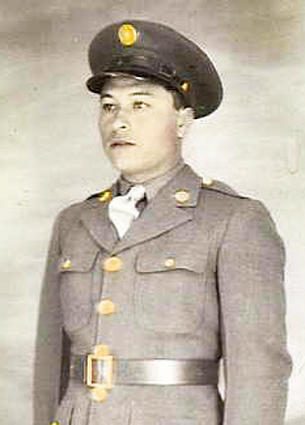

Louie Hernandez
Company D 1st Battalion 22nd Infantry
4th Infantry Division
KIA 06/14/1944
Louie Hernandez was born in Pueblo, Pueblo County, Colorado on January 29, 1919.
He was drafted into the Army on
November 24, 1942 at Denver, Colorado. His home of residence was
listed
as Gill, Colorado, and his civilian occupation was listed as Farm
Hands, General Farms.
He had completed one year of High School and was single with
dependents. His religion
was listed as Catholic.
|
Left: Louie Hernandez
Photo courtesy of |
He was awarded the Good Conduct
Medal as a Private in Company D
in General Orders No. 14 Headquarters 22nd Infantry dated
December 31, 1943
at Fort Jackson, South Carolina.
Private First Class Hernandez
was killed in action in France, during 1st Battalion's attack
against
the Quineville Ridge on June 14, 1944.
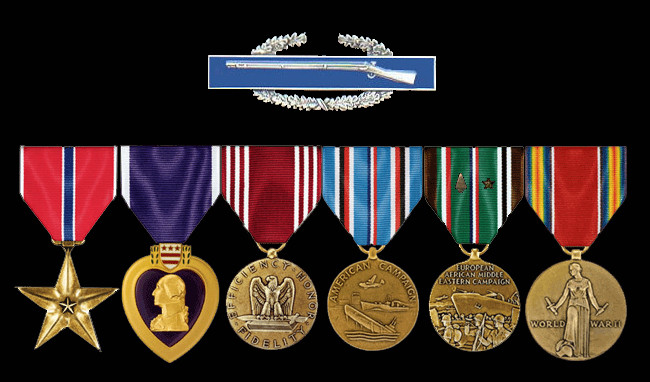
Decorations of Louie Hernandez
Louie Hernandez was buried in
the temporary U.S. Military Cemetery
Sainte Mere-Eglise #2 at Carentan, France in Block B Row 7 Grave
130 and was moved to the permanent
cemetery at Colleville-sur-Mer, in the 1947-1949 time frame, when
the temporary cemeteries were shut down.
Burial:
Normandy American Cemetery and Memorial
Colleville-sur-Mer
Departement du Calvados
Basse-Normandie, France
Plot: Plot F Row 18 Grave 40
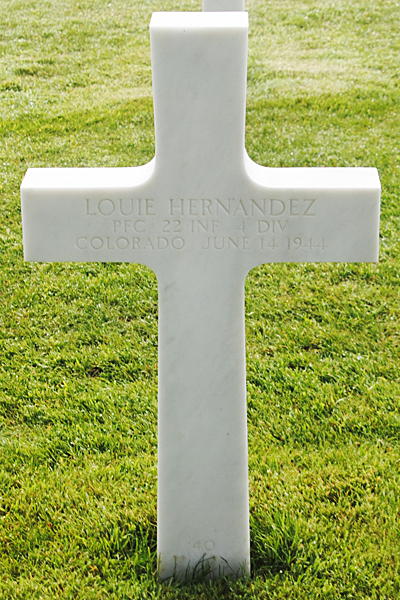 |
Grave marker for Louie Hernandez Photo by Frogman |
In 2019 during the 75th
anniversary of the D-Day landings fifteen teacher-student pairs
from schools across the United States travelled to the Normandy
American Cemetery at
Colleville-sur-Mer in Normandy, France to pay honor to American
soldiers who lay at rest
in the cemetery.
Cassie Dobbins Moore, a teacher at Lakewood High School in
Lakewood, Colorado and her student Elizabeth Crim
made the journey to honor Louie Hernandez from Company D 22nd
Infantry. Together the teacher-student pair
had researched Louie Hernandez and had scanned documents at the
National Archives in order to write his story.
Their finalized biography of Louie Hernandez can be viewed at the
link below. The link is to a PDF file.
To return to this page after reading it click the
"back" arrow in the file.
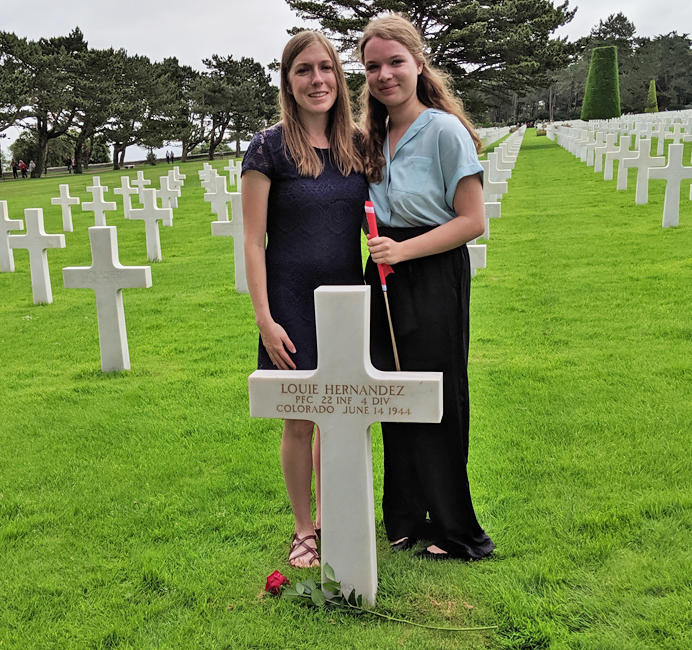
Above: Left, Cassie Dobbins Moore - right, Elizabeth Crim at the grave of Louie Hernandez 2019
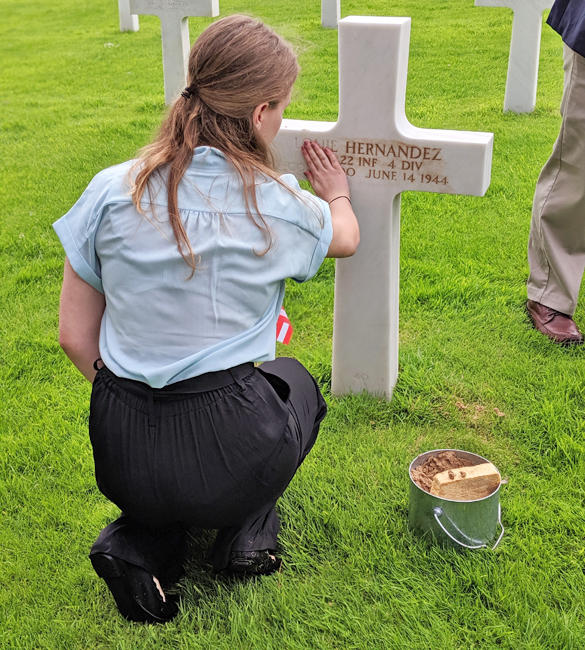
Above: Elizabeth Crim rubs sand across the grave marker to bring out the details 2019
Eulogy for Louie Hernandez
by Elizabeth Crim
When you sit down to write an
obituary about a man you have never met, you have to stop and
think about what you really know. You have to ask yourself, how
can I do justice to a person that
was very much real and yet I only know through after action
reports, a name buried in a long list,
or a newspaper clipping faded and forgotten?
I can begin by confidently
saying we know a little about Louie Hernandez.
We know Louie was born and raised in Gill, Colorado by his
parents Antonio and Marianna.
Louie had two brothers, John and Manuel, and he attended the Gill
school before dropping out
his second year of highschool to work as a laborer on a beet farm
until his conscription in
November of 1942.
We know that Louie went through
basic training in Texas where he would eventually join the
22nd Infantry Regiment of the 4th Division in Georgia in the
spring of 1943. For the next year,
Louie’s Regiment would jump from training bases along the
coast, including Ft. Gordon,
Georgia, Ft. Dix, New Jersey, Camp Gordon Johnston, Florida, and
finally Fort Jackson, South
Carolina to begin their preparation to head overseas. While in
South Carolina, Louie was
awarded the Good Conduct Medal in Orders on December 31, 1943.
We know that Louie and the rest
of his regiment left for England on January 18, 1944. They
would arrive in Liverpool, England on January 29th and head south
to the Devon coast where
they would spend the following four months training for the
invasion of Normandy. Here, Louie
and the 22nd would do their most intensive preparation for D-Day
in Slapton Sands, along the
south Devon coast of England, between March and April of 1944. At
this location, the beach
closely resembled the topography of Utah Beach.
We know that as a member of Dog
Company, a heavy weapons company, Louie was either part
of the machine gun or mortar crew charged with protecting the
front lines. On the morning of
June 6, 1944, Louie and the 4th Infantry Division were charged
with landing and securing Utah
Beach and ultimately the Cotentin Peninsula and important port
city of Cherbourg. Louie, along
with the 1st and 2nd Battalions of the 22nd, landed in the second
wave at approximately 10:00 hours.
We know that after a successful
invasion, on June 7th, Louie was first injured in battle and
removed from the front lines for several days to receive medical
care after the First Battalion
moved toward the German stronghold at Crisbecq through
Ravenoville and St. Marcouf. Louie,
living up to his regimental motto, “Deeds, Not Words,”
would rejoin the 22nd on June 10th as
the First Battalion attacked Fontanay Sur Mer in an effort to
relieve some of the pressure on the
Third Battalion as they attempted to take Ozeville. These efforts
continued for several days until
June 13th when the Third Battalion was able to secure Ozeville.
And we know that On June 14,
1944 all three battalions of the 22nd Infantry were directed to
attack and secure Quineville Ridge and two hills to the east in
preparation for taking the town.
This victory was essential for protecting the continued unloading
at Utah Beach and overcoming
the German’s best natural defenses in the area. It was in
the battle for Quineville Ridge that
Louie lost his life. Private First Class Louie Hernandez was
killed in action on June 14, 1944 and
was awarded the Purple Heart with oak leaf cluster for his
service. This medal represented both
his injury from June 7th and the wound on June 14th that resulted
in his untimely death.
But, how much do we really know?
How much can government documents and headstones tell
you about a person that hoped and worried and died before he
could tell his own story?
The only personal documents we
were able to find for Louie were a series of short
correspondences between his parents and the effects Bureau. After
Louie’s belongings were sent
to his family, his father responded with the following note:
“Dear Sir, Just a few lines
to let you know that we receive our son’s billfold with some
pictures
in it but we did not receive his wrist watch. We sure hope that
you would try and look for it if its
possible because his watch was a gift from his mother and family.
I am sorry to ask for all this
trouble.”
After studying a Louie for
months, finding something as seemingly insignificant as a letter
from
his parents meant more than we anticipated. Throughout this whole
process, it was easier to
immortalize Louie as a hero, which is justified. But it’s
harder to admit the large chunk that we
don’t know, and probably will never know: The goods, the
bads, the in-betweens. The family
relationships, the stories, the importance of a small gift.
Antonio wrote, “We are very
thankful from here about where our loved one is buried...it is
better
for his grave to remain over there.” Louie’s
parents’ letters seem to express gratitude that his
final resting place would be beside his fellow heroes.
Antonio and Marianna were never able to visit Louie at his gravesite.
Although Louie left behind no
immediate kin who could share his story, he was survived by a
close and growing family. At the time of his mother,
Marianna’s, passing in 1959, she was
survived by her remaining sons, John and Manuel, 10
grandchildren, and 18 great grandchildren.
Of all the things we do not know about Louie, the most important
is the effect of his legacy. We
do not know if any of his nieces, nephews, or other descendants
know the story of their Uncle
Louie or of the sacrifices he made for their freedoms. We
don’t know Louie’s importance in the
Hernandez family history, but we hope it’s as powerful for
the family he left behind as it has
been for us.
So as we remember Louie for
everything that we know he was, a Mexican-American from Gill,
Colorado, a member of the 22nd Infantry Regiment of the 4th
Division, and a soldier that died in
the Battle of Normandy, I want to remember Louie for everything
we don’t know. I want to
remember Louie for his personality, his family, his hopes, his
wristwatch and the story behind it,
and even his face, which we’ve been imagining without a
photograph for help.
To both the stranger and the very close friend we’ve met in the past six months, thank you.
In October 2023 the helmet
belonging to Louie Hernandez was found in Normandy, in an attic
in Valogne.
Theophile Odaert secured it for his collection, and brought it to
Louie's grave in the Normandy American Cemetery.
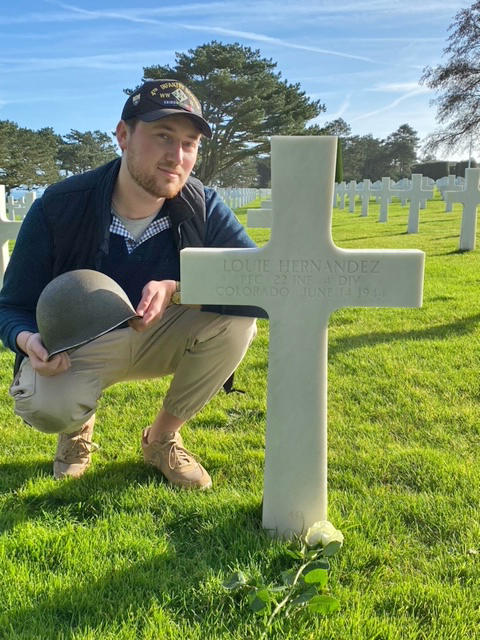
Above: Theophile Odaert
with the helmet of Louie Hernandez,
at Louie's grave.
Photo courtesy of Theophile Odaert
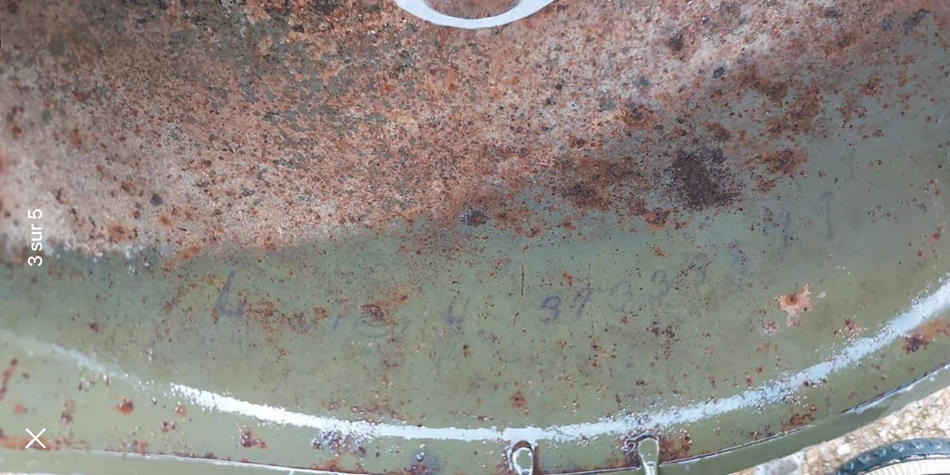
Above: The helmet was identified to Louie Hernandez by his first
name, the first letter of his last name,
and his serial number, which he had written in his helmet.
Photo courtesy of Theophile Odaert
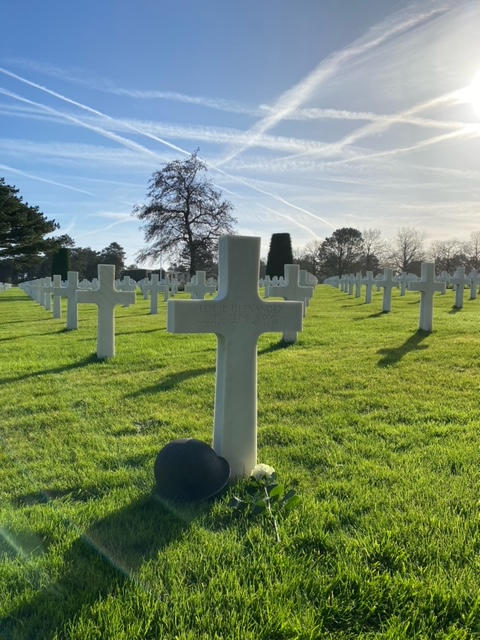
Louie's helmet and a rose at his grave.
Photo courtesy of Theophile Odaert
Thanks to Cassie Dobbins Moore and Elizabeth
Crim for their assistance
in the preparation of this page.
Top photo of Louie Hernandez courtesy of Theophile Odaert
Home | Photos | Battles & History | Current |
Rosters & Reports | Medal of Honor | Killed
in Action |
Personnel Locator | Commanders | Station
List | Campaigns |
Honors | Insignia & Memorabilia | 4-42
Artillery | Taps |
What's New | Editorial | Links |